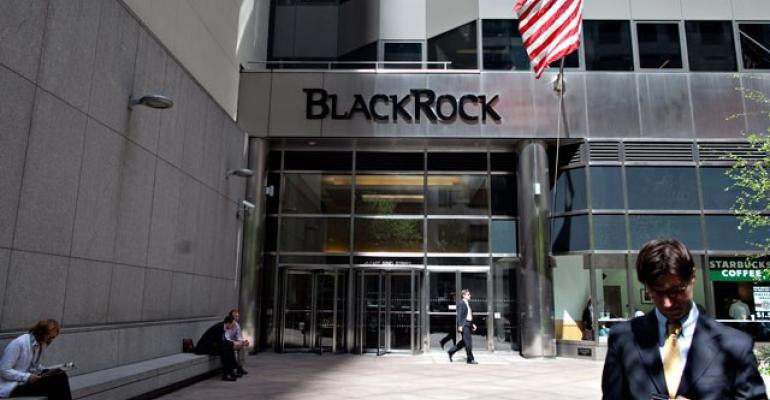By Carolina Wilson
(Bloomberg) --It’s not enough for BlackRock Inc. to command one of every three dollars investors send to fund companies in America. Now it wants to control their minds, too.
Operatives of the New York-based behemoth will be fanning out to brokerages around the country in the next few months, trying to convince advisers to move away from the standard dichotomy of growth and value in conversations with clients about buying ETFs. Instead, they’ll be pushing everyone to start talking like quant traders.
It’s Investing 101 at the world’s biggest money manager, which eagerly wants to cement in the public consciousness an academic version of money management known as smart beta. In BlackRock’s vision, stock characteristics known as “factors” will become the lingua franca of brokerage offices, and old categories that date to Warren Buffett’s mentor Benjamin Graham will be replaced with words like momentum, size, volatility and yield, according to Rob Nestor, BlackRock’s head of iShares smart beta.
The campaign is something of a broadside against Morningstar Inc., purveyor of the “style box,” an investing tool that has guided a generation of investors in allocating money to stocks. The familiar diagram has been the lens through which retail investors view equities for 25 years, dividing them into three styles -- value, growth and blend -- and three sizes -- small, medium and large capitalization.
“I’ve certainly seen previews of what they’re going to do to become more vocal and more public with in terms of their messaging,” said Ben Johnson, director of global ETF research at Morningstar Inc. “This is also something BlackRock’s competitors are going to be very keen to do, to deliver a new Rosetta stone to current and prospective clients to help them decipher the language of portfolio construction.”
Style Drift
Among advisers, Morningstar’s nine-box grid is so ubiquitous that managers are chastised for “style drift” if they stray too far from it, according to James Pillow, managing director at Moors & Cabot Inc., which has around $6 billion under management. But BlackRock’s undaunted, saying its broader categories are part of an inevitable evolution in investing.
“We fundamentally believe that factors are the most precise drivers of risk and return in portfolios,” Nestor said. “Eventually, investors will need to look through a holistic factor lens, and that’s what the ‘factor box’ will bring in.”
First publicized by researchers in the 1960s, factor investing tries to exploit behavioral biases that supposedly allow collections of stocks grouped by traits such as volatility and momentum to beat the broader market. Hedge funds pursing factor-based investing have seen assets swell fourfold to $98 billion since 2013, according to BarclayHedge. The watered-down version that finds its way into U.S.-listed smart beta ETFs has attracted $730 billion.
To get mom and pop to think in terms of factors when allocating money and rating performance, BlackRock envisions a two-step induction. First, customers will be taught that the styles as conceived by Morningstar are factors in disguise. Second, the “value and growth” distinction will refine itself into “value, size, momentum, quality, yield and volatility.”

As often happens in investing, ETF issuers sometimes walk a fine line between education and marketing. Smart beta may have a venerable academic pedigree, but firms will inevitably try to get customers to standardize on their own product categories, ones that sound official but still represent judgment calls even among devotees.
Why should anyone accept BlackRock’s definition of factors and not someone else’s, asks Campbell Harvey, professor of finance at Duke University and adviser to Research Affiliates LLC, which competes with BlackRock in offering factor-based solutions. “What does value or quality mean to them? Everybody has a different version of that.”
Moreover, not everyone agrees on what factors are supposed to do. Some providers bill them as tools for diversification, others say they’re a way to unlock market-beating returns. The challenges of forming a comprehensible message in this area won’t make it any easier to persuade retail investors to toss out the trusted “style box” categories of growth and value.
“The idea that allocating across the style boxes created a properly allocated portfolio is folly,” said Moors & Cabot’s Pillow. But getting investors to give up the tool they’ve grown accustomed to through years of use “will be very difficult.”

BlackRock isn’t the only firm interested in popularizing smart beta. But it’s certainly been a profitable focus for the firm, since at the end of 2017 more than half of the its ETF assets came from U.S.-listed smart beta funds, according to Bloomberg data. Five years ago, it was only about 34 percent, the data show.
“Investors will benefit from a rising tide floating all boats, even if others try to fill this gap in their own ways” with their own products, Nestor said. “But certainly we’re focused on our products reflecting that, and if we do a good job, we’ll get our fair share.”
To contact the reporter on this story: Carolina Wilson in New York City at [email protected] To contact the editors responsible for this story: Arie Shapira at [email protected] Yakob Peterseil, Chris Nagi





